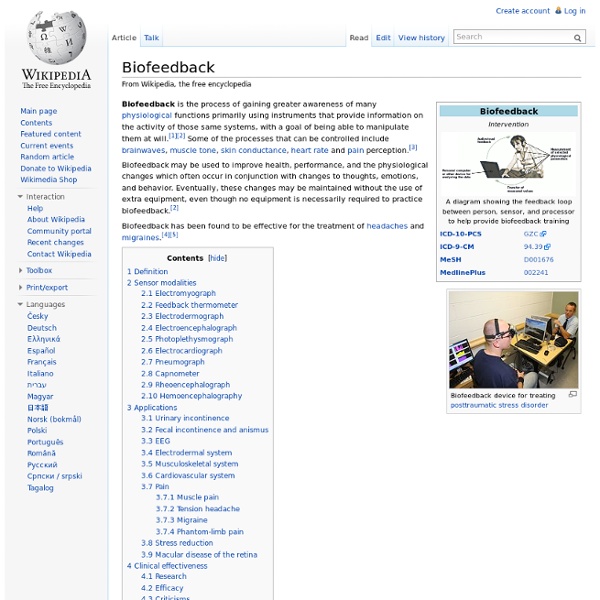Zoom
Trash
Related:



Biofeedback Biofeedback is a technique you can use to learn to control your body's functions, such as your heart rate. With biofeedback, you're connected to electrical sensors that help you receive information (feedback) about your body (bio). This feedback helps you focus on making subtle changes in your body, such as relaxing certain muscles, to achieve the results you want, such as reducing pain. In essence, biofeedback gives you the power to use your thoughts to control your body, often to help with a health condition or physical performance. Why it's doneJan. 26, 2013 References About biofeedback.
Audio feedback Howling caused by a circular path in an audio system Block diagram of the signal-flow for a common feedback loop.[1]: 118 Audio feedback (also known as acoustic feedback, simply as feedback) is a positive feedback situation which may occur when an acoustic path exists between an audio input (for example, a microphone or guitar pickup) and an audio output (for example, a loudspeaker). History and theory[edit] Distance[edit] To maximize gain before feedback, the amount of sound energy that is fed back to the microphones must be reduced as much as is practical. Directivity[edit] If monitors are oriented at 180 degrees to the microphones that are their sources, the microphones should have a cardioid pickup pattern. Frequency response[edit] Feedback can be reduced manually by "ringing out" a sound system prior to a performance. To avoid feedback, automatic anti-feedback devices can be used. Deliberate uses[edit] Early examples in popular music[edit] Introductions, transitions, and fade-outs[edit]
Bioelectromagnetics Study of electromagnetic fields and biological entity interaction Biological phenomena [edit] Bioelectromagnetism is studied primarily through the techniques of electrophysiology. Several animals are suspected to have the ability to sense electromagnetic fields; for example, several aquatic animals have structures potentially capable of sensing changes in voltage caused by a changing magnetic field,[2] while migratory birds are thought to use magnetoreception in navigation.[3][4][5] Bioeffects of electromagnetic radiation Most of the molecules in the human body interact weakly with electromagnetic fields in the radio frequency or extremely low frequency bands. Many behavioral effects at different intensities have been reported from exposure to magnetic fields, particularly with pulsed magnetic fields. A strong changing magnetic field can induce electrical currents in conductive tissue such as the brain. Effects of electromagnetic radiation on human health
The Science of Biofeedback & Proper Breathing Climate change feedback Feedback related to climate change Climate change feedbacks are important in the understanding of global warming because feedback processes amplify or diminish the effect of each climate forcing, and so play an important part in determining the climate sensitivity and future climate state. Feedback in general is the process in which changing one quantity changes a second quantity, and the change in the second quantity in turn changes the first. Positive (or reinforcing) feedback amplifies the change in the first quantity while negative (or balancing) feedback reduces it.[3] The term "forcing" means a change which may "push" the climate system in the direction of warming or cooling.[4] An example of a climate forcing is increased atmospheric concentrations of greenhouse gases. By definition, forcings are external to the climate system while feedbacks are internal; in essence, feedbacks represent the internal processes of the system. Positive[edit] Carbon cycle feedbacks[edit] Hydrates[edit]
Beneficial acclimation hypothesis Hypothesis of physiology The beneficial acclimation hypothesis (BAH) is the physiological hypothesis that acclimating to a particular environment (usually thermal) provides an organism with advantages in that environment. First formally tested by Armand Marie Leroi, Albert Bennett, and Richard Lenski in 1994, it has however been a central assumption in historical physiological work that acclimation is adaptive. History and definition[edit] Acclimation is a set of physiological responses that occurs during an individual's lifetime to chronic laboratory-induced environmental conditions (in contrast to acclimatization). The initial definition of the BAH, as published in 1994 in the Proceedings of the National Academy of Sciences by Leroi et al., is that “acclimation to a particular environment gives an organism a performance advantage in that environment over another organism that has not had the opportunity to acclimate to that particular environment.”[2] 2. Experimental tests[edit] 1. 2. 3.
The Science of Biofeedback Feedback informed treatment Feedback Informed Treatment (FIT) is an empirically supported, pantheoretical approach for evaluating and improving the quality and effectiveness of behavioral health services, originally developed by psychologist Scott D. Miller.[1][2] It involves routinely and formally soliciting feedback from clients regarding the therapeutic relationship and progress of care and using the resulting information to inform and tailor service delivery.:[1] FIT utilizes empirically validated, client rated measurement tools at each session. Although any validated measures could be used, due to their brevity, the Outcome Rating Scale (ORS)[3] and Session Rating Scale (SRS) are commonly employed by FIT Practitioners. A number of studies and meta-analyses have demonstrated the benefit of routinely monitoring and using client outcome data and feedback to inform care.[4] Studies using the ORS and SRS document: Additional Readings[edit] External links[edit] References[edit]
Energy budget An energy budget is a balance sheet of energy income against expenditure. It is studied in the field of Energetics which deals with the study of energy transfer and transformation from one form to another. Calorie is the basic unit of measurement. P = C - R - U - F or P = C - (R + U + F) or All the aspects of metabolism can be represented in energy units (e.g. joules (J);1 calorie = 4.2 kJ). Energy used in the maintenance will be Endothermy and ectothermy[edit] Energy budget allocation varies for endotherms and ectotherms. References[edit] Kumar, Ranjan (1999): Studies on Bioenergics modelling in a fresh water fish, Mystus vittatus (Bloch), Ph.D thesis, Magadh University, Bodh Gaya.B.R.